| |
|
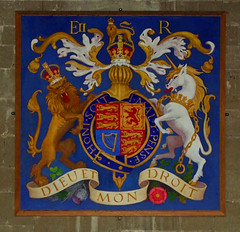 |
|
Lavenham sits quietly away
from any major road and from any recent
century, somewhere near the middle of
Suffolk. Despite its remoteness, it is
one of the major tourist spots in the
county. People come to Lavenham for
History, and undeniably there's lots of
it in this pleasant little town. Town?
Well, yes, I think so. As Alec Clifton
Taylor pointed out, Lavenham may have
barely half the population of nearby Long
Melford, but when we walk their streets
we are never in any doubt that Long
Melford is a village whilst Lavenham is a
town. As with Salle and Cawston in
Norfolk, the two neighbouring towers are
visible for miles around, and I suppose
that some people prefer Long Melford
church to Lavenham church, and some the
other way around. It
is a commonly held belief that Lavenham
was one of the twenty largest towns in
England in the late middle ages, but
perhaps it would be truer to say that it
was among the twenty richest ones. The
money came from the production of cloth,
and it was this money which gave Lavenham
its still-familiar townscape. For when
the Dutch weavers settled in Essex at the
time of the Reformation, and they were
prepared to work for less money than the
indigenous population (sound familiar?)
the Suffolk wool towns and villages fell
into recession. Not much would happen
here again until the later years of the
19th Century, and that is why there is so
much surviving History for people to come
and gawp at, including this tremendous
church.
|
St
Peter and St Paul dominates the western approach
to Lavenham, and the rest of the town falls away
below it. It was built in a single, lengthy
campaign from the 1480s to the 1520s, and was
bankrolled by the wealthy cloth merchant
families, particularly the Springs and the De
Veres. These were the parvenu families
which had grown wealthy on the spoils of the
Black Death, as the old estates were broken up
and land became a commodity to be bought and
sold. These families were the movers and the
shakers of the 15th Century, whose hot-housing of
the economy and need to capture the imagination
of their parishes led inexorably to
Protestantism, the Reformation, the rise of
capitalism and ultimately to the Industrial
Revolution. If you want to understand the modern
world, Lavenham is a good place to start.
The
proportions of church to graveyard are so like
the near-contemporary situation at Southwold that
it must have been seen as the late medieval urban
ideal. The tower may have been the design of the
master mason John Clerk; the nave, aisles and
clerestories are that of his successor John
Wastell, who was responsible for the bodies of
Great St Mary in Cambridge and St Mary at Saffron
Walden, both which bear considerable
similarities. The only surviving part of the
pre-1480s church is the chancel, which is now
almost hidden by the newer chancel aisles and
chapels. These seem to grip the chancel, and
their great windows create a dynamic effect with
the smaller ranges of the nave and clerestory.
The result is a dramatic tension, as if this were
a trap about to spring, and which encourages the
sense of the Perpendicular, of a structure
lifting to heaven. The pierced tracery of the
nave, aisles and chancel chapels creates the
feeling of a clustered and fortified city, the
blockish tower a sense of permanence. Long
Melford church may have its fabulous range of
large nave windows creating a glass house effect,
but its early 20th Century tower cannot compete
with Lavenham's late medieval unity. So far,
then, Lavenham 1 Long Melford 0.
| You enter through the south
porch, an elegant and organic extension
of Wastell's aisle, and you step into a
church which has a quite different
feeling to that of Long Melford. There,
you see light - here, it is stone which
dominates. The magnificent arcades
stretch eastwards like an avenue of trees
in a forest, the panelling and carving
above them of the highest quality.
Beneath them, the interior is light and
spacious, despite the 19th Century
benches. It would be such an improvement
if they could be removed and replaced
with modern chairs. In truth, they are
just one symptom of what was an
overwhelming series of 19th Century
restorations here. In
fact, there are surprisingly few medieval
survivals. The best of these are the
early 16th Century parclosed chantry
chapels at the eastern end of the north
and south aisles. That in the north aisle
is the famous Spring Chantry, fabulously
carved in a bubbly and luxuriant style.
Mortlock thought that its similiarities
with the screen of Henry VII's chapel in
Westminster Abbey suggested it was the
work of Flemish craftsmen. That in the
south aisle is to the Ponder family.
Interestingly, the tomb inside it was
brought into the church from the
graveyard early in the 20th Century.
|
|
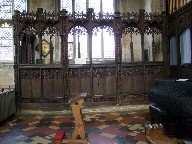 |
The roof to the south aisle
is the original, a delightful cavalcade of
carving which is set off well by the cleared
floor beneath it, a dramatic setting for the
font. Incidentally, the font is rather curious.
It predates the rebuilding of the church by a
century or so, and its scenes are unfamiliar and
rather hard to decode. The late medieval stalls
in the chancel lift to reveal delightful
misericord carvings. The pelican in her piety is
a familiar medieval image, but the others are
rarer, and odder. There are two musicians, a man
and a lady with the hindquarters of beasts. He
plays a violin with a pair of tongs, she plays a
hurdy-gurdy, believed to be the earliest
representation of this instrument. Another man is
playing a pig as if it were a pair of bagpipes.
There is a jester, and a pair of spoonbills
pecking at the head of a man.
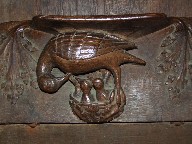 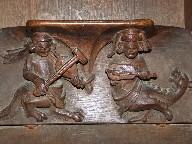
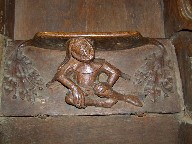 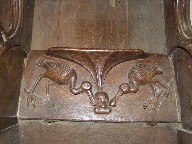 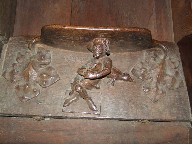
Given
the vastness and rich patronage of this church,
it is perhaps surprising that there are so few
surviving brasses. The inlays survive, but the
brasses themselves are gone, including that in
the Spring chantry, perhaps vandalised by 17th
Century puritans, but far more likely stolen by
18th Century metal thieves. Again, sound
familiar? All the pre-Reformation brasses were
lost. The only two survivors are in the middle of
the chancel, a pretty little chrysom brass of a
dead baby, and its inscription. He was Clopton
D'Ewes, and he died in 1631 at the age of just
ten days. Similarly, apart from the chantries,
roofs and stalls, not much early woodwork
survives. The medieval benches are all lost. The
screens are restored, though they are undeniably
lovely. The chancel and its chapels are dominated
by fairly mundane 19th Century glass. The best
glass in the church is in the west window below
the tower, and depicts scenes from the narratives
of St Peter and St Paul. It was fortunately
recovered and restored after a WWII bomb blew it
out.
The
shop, which used to sprawl across the western end
of the nave, is now discreetly coralled in the
north-west corner, and beside it is the best
second hand book stall I have ever come across in
an English church. And this church is always full
of visitors, you couldn't possibly hope to be
alone in here like you often can at Long Melford.
Whereas Melford church is set apart from its
village across the wide green, you can step into
Lavenham church within minutes of leaving a shop
or pub. This isn't quite sufficient to give it a
second goal, I fear, but it does mean it is no
great effort to come and see. And when you step
back out, the main street spreads eastwards with
its half-timbered buildings and pleasant
cottages. You can wander down to the square used
in the recent Harry Potter films, where the
medieval guildhall tells you as much about the
15th Century wealth of the place as John
Wastrell's church does. You can admire the Swan
hotel, a range of 15th Century buildings which
will probably have a wedding reception on if you
are here on a summer Saturday, but which is in
any case far too expensive for the likes of you
and me. And after that? Well, mine's a pint in
the Greyhound.
So
much for History then. And what is History? Is it
things that don't change, or the constantly
unfolding process by which they do? Whenever I
set foot in Lavenham church I recall Nikolaus
Pevsner's famous observation that a bicycle
shed is a building, a cathedral is architecture.
This is quoted out of context so often that it is
necessary to recall that Pevsner was not
suggesting that a mere building was a bad thing.
For him, a building is a space in which humans
move, which they use and inhabit. A good church
should be architecture, but of course it should
be a building too. Architecture does not require
people, but a building does. Some would say that
it is more important for a church to be a
building than for it to be architecture.
| The reason I recall
Pevsner's misquoted observation is that I
think this place is architecture rather
than a building. It is so of a piece, so
pleased with itself, so coolly rational
in its perpendicular grandness, that it
does not need its people to be what it
is. The years have altered its fixtures
and fittings it is true, but they do not
feel an organic part of the structure as
a whole. Whereas Long Melford church
feels lived in, like a
touchstone down the long parish
generations, Lavenham church has a colder
feel, as if we were in a museum. The
sense of History, meaning the past, is
undeniable, but where is the story of the
ordinary people, where is the sense of
the numinous handed down? This is more
than an equalising goal, I fear, and when
the battle lines are drawn and I must
step to one side or the other I will
always declare for Long Melford rather
than Lavenham. People
who come to Lavenham hope to see the past
and immerse themselves in it, and have a
cream tea and buy some pot-pourri, and
the jolly best of luck to them. Rather
that than the dull recitation of dates
and the names of great men and battles
that I had to copy down from the
blackboard in my wasted years at
Cambridgeshire High School for Boys back
in the 1970s. How on earth could they
have made history so boring? Perhaps the
school's oafish, sadistic headmaster CW
Hill - the C stood for Colin, but to us
he was Crip, because of his striking
resemblance to the wife-murderer Dr
Crippen - had something to do with it.
Whatever, it failed to capture my
enthusiasm, and I was made to give it up,
along with English Literature, and pursue
Science O Levels instead.
Perhaps I should have
thanked him, because History and English
Literature are just about the only things
I've been interested in since.
|
|
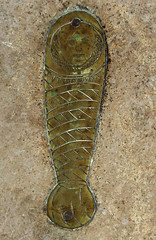 |
|
|
|

